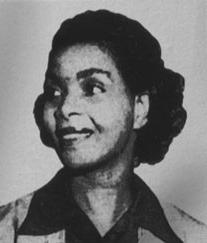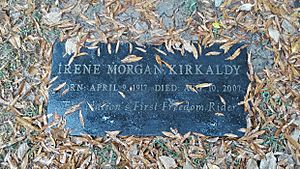Irene Morgan facts for kids
Quick facts for kids
Irene Morgan
|
|
|---|---|
 |
|
| Born | April 9, 1917 |
| Died | August 10, 2007 (aged 90) |
| Children | 2 |
Irene Amos Morgan (born April 9, 1917 – died August 10, 2007), also known as Irene Morgan Kirkaldy, was an African-American woman. She was from Baltimore, Maryland. In 1944, she was arrested in Middlesex County, Virginia. This happened because she refused to follow a state law that forced racial segregation on public transportation.
She was traveling on a bus that went between states. These buses followed federal laws. Irene refused to give up her seat in what the driver called the "white section." At that time, she worked for a company that made B-26 Marauder airplanes for the war.
After her arrest, Morgan got help from lawyers. The NAACP Legal Defense and Educational Fund took on her case. She was represented by William H. Hastie and Thurgood Marshall. Her case, Irene Morgan v. Commonwealth of Virginia, went to the Supreme Court of the United States. In 1946, the Court made an important decision. They said the Virginia law was unconstitutional. This was because the Commerce Clause of the U.S. Constitution protects travel between states. However, many states in the South did not follow this ruling for many years.
Contents
Irene Morgan's Early Life and Family
Irene Morgan was born in 1917 in Baltimore, Maryland. She went to local schools and was raised as a Seventh-day Adventist. Irene married Sherwood Morgan Sr. They had a son and a daughter together. Sherwood Morgan Sr. passed away in 1948.
During World War II, Irene helped with the war effort. She worked at Glenn L. Martin, a company that made aircraft. She helped build B-26 Marauder airplanes.
Later, she married Stanley Kirkaldy. They lived in Queens, New York City. Together, they ran a dry-cleaning business. They also had a child-care center. When she was in her 60s, Irene started college. She went to St. John's University in New York City. She earned her bachelor's degree when she was 68 years old. Five years later, she earned a master's degree in Urban Studies from Queens College.
Her Arrest and Court Case
Irene Morgan was visiting her mother in Gloucester County, Virginia. She was hoping to go back home to Baltimore. She wanted to continue working on the airplane production line. On July 16, 1944, Morgan boarded a Greyhound bus. She sat next to another African-American woman who had a baby.
At that time, African-American passengers could not sit next to white passengers. But there were no special "black" or "white" seats on this bus. When a white couple got on the bus, the driver told Morgan and her seatmate to give up their seats. Her seatmate moved to the back of the bus. But Irene Morgan refused to move.
When Morgan would not move, the bus driver called a sheriff. The sheriff gave Morgan an arrest warrant. But she tore it up and threw it out the window. When the sheriff tried to pull her from her seat, she resisted. She was determined not to move. Another sheriff came, and she continued to resist being removed from her seat.
Morgan was arrested. She was charged with resisting arrest. She was also charged with breaking Virginia's Jim Crow transit law. On October 18, 1944, Morgan went to court. She agreed to pay a $100 fine for resisting arrest. But she refused to say she was guilty of the segregation violation.
Maryland did not have segregation laws for buses traveling between states. So, Virginia's Jim Crow law might not apply to Morgan. With help from the NAACP, Morgan's case went to the Virginia Supreme Court. This court said she had broken the law. Morgan then took her case to the U.S. Supreme Court, and she won.
The U.S. Supreme Court Case
Irene Morgan's case was called Irene Morgan v. Commonwealth of Virginia. It was argued by William H. Hastie. He was a former governor of the U.S. Virgin Islands. He later became a judge. Thurgood Marshall from the NAACP was also a lawyer on her case. He later became a U.S. Supreme Court justice.
In 1946, the Supreme Court of the United States ruled 6 to 1. They said that Virginia's state law forcing segregation on buses that traveled between states was unconstitutional. The lawyers used a smart plan. Instead of using the Equal Protection Clause of the 14th Amendment, they argued that segregation on interstate travel went against the Commerce Clause of the U.S. Constitution. This clause deals with trade and travel between states.
Irene Morgan said, "If something happens to you which is wrong, the best thing to do is have it corrected in the best way you can." She added, "The best thing for me to do was to go to the Supreme Court."
In 1960, in a case called Boynton v. Virginia, the Supreme Court used the Morgan ruling again. They said that bus stations used for interstate travel also could not be segregated. But many Southern states still did not obey the Morgan v. Virginia ruling. African Americans were still arrested when they tried to use these facilities. This led to many peaceful protests. One famous protest was the Freedom Rides in 1961. White Southerners sometimes attacked the Freedom Riders. This brought more attention to the South's Jim Crow system.
The Journey of Reconciliation
Irene Morgan's case inspired the 1947 Journey of Reconciliation. During this event, 16 activists from the Congress of Racial Equality rode on buses through the Southern states. They wanted to see if the Supreme Court ruling was being followed. The activists rode on both Greyhound and Trailways buses. They often had a Black and white person sit together in the "white" section of the bus. Other activists pretended to be regular passengers. They sat in the sections that were "reserved" for them by segregation laws.
The group traveled through Virginia without problems. But when they reached North Carolina, they faced arrests and violence. By the end of the Journey, the protesters had done over 24 "tests." They were arrested 12 times and faced dangerous mob violence. Even though the Morgan decision said segregation on interstate buses was illegal, North Carolina police arrested civil rights activist Bayard Rustin. A jury found him guilty. He was sentenced to 22 days on a chain gang for breaking the state's segregation laws. This happened even though he was riding on a bus that traveled between states.
The 1947 Journey of Reconciliation was important. It used nonviolent direct action. It also inspired the well-known Freedom Rides of 1961. These rides were also organized by CORE.
Death
Irene Morgan was a member of the Seventh-day Adventist Church her whole life. She passed away on August 10, 2007. She was 90 years old. She died at her daughter's home in Gloucester, Virginia. Her funeral was held at Gloucester High School.
Legacy and Honors
- In 1995, Robin Washington made a documentary called You Don't Have to Ride Jim Crow!. It was shown on New Hampshire Public TV. It featured Morgan Kirkaldy and others from the 1947 "Journey of Reconciliation." This brought new attention to her important contributions.
- In 2000, Gloucester County, Virginia, honored Morgan Kirkaldy. This was part of their 350th anniversary celebration.
- In 2001, President Bill Clinton gave her the Presidential Citizens Medal. This is a special award.
- In 2002, PBS showed a four-part series. It was called The Rise and Fall of Jim Crow. It included an article about Morgan v. Virginia.
- In 2010, Kirkaldy was added to the Maryland Women's Hall of Fame.
Representation in Other Media
- Robin Washington, producer: You Don't Have to Ride Jim Crow! (1995), a documentary.
See also
 In Spanish: Irene Morgan Kirkaldy para niños
In Spanish: Irene Morgan Kirkaldy para niños


